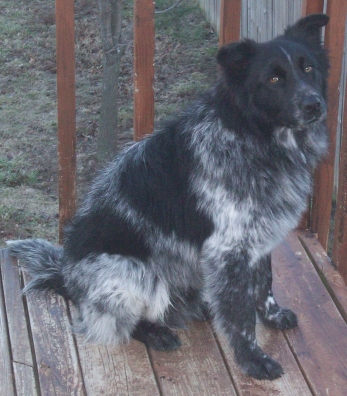
I Love a Pit Bull Smile
I’ve had a number of dogs of various breeds in my life. One special dog was a Pit Bull/Mastiff named Squash (because of his orange color). His previous owners kept him in the back yard tied with a thick and short chain around the tree. When they moved, they just left him there. So my mom took him in. Squash understandably had a few issues due to his life tied around that tree, but with care and understanding he turned out to be a great family dog. I remember walking him as a girl and everyone being afraid of him. Some people couldn’t believe my mom would let me and my little sister be around such a big, strong, and mean-looking dog. But Squash would never hurt us. Because of his sweet nature, he was one of the most memorable dogs of my childhood.

This isn’t a photo of Squash, but you get what I mean about the orange color.
With that being said, let me present to you this article about Pit Bulls. This is an article written by Randi Adams. Randi is a blog-from-home mother of three from California.
It’s easy to see golden retrievers adored as loving, family-oriented companions or chihuahuas as cute accessories that are dressed up and toted around. It’s called breed generalization, and pit bulls are victims of sweeping unfair generalizations such as “dangerous,” “a community menace” and “unpredictably aggressive.” Dog stereotypes and breed generations do originate though somewhere, somehow. Media attention that sensationalizes a tragic story involving a pit bull, or even the Michael Vick illegal dog fighting case disservice the breed that typically has a good nature.
The Fighting Truth
Pit bulls have been historically bred to be a fighting dog, and as a physically powerful, “high drive” breed, they have been traditionally trained to be an aggressive threat against other animals, as the ASPCA reveals. Because of the breed’s long history with fighting, the pit bull has a naturally strong propensity to react to other dogs. Pets for Patriots emphasizes that dog breeds of all kinds can exert aggressive behaviors, but a pit bull can end up inflicting more serious injuries and damage because of its size and strength.
Dog fighting was certainly more common one hundred years ago, and the American Pit Bull Terrier was bred to be a friendly and gentle dog, explains Pets for Patriots. At one time, the pit bull was one of the most popular dogs for American families. The pit bull image was even represented on World War One posters as a symbol for bravery and reliability.
Human Fault
ASPCA, the non-profit organization dedicated to the prevention of animal cruelty, asks “why the bad rap?” First, pit bulls can be a macho status symbol because of their intimidating appearance. Breeders irresponsibly and carelessly breed pit bull puppies for people who excite over the pit bull’s tough image. Dog owners also have their fair share in perpetuating the pit bull reputation. Dog owners may encourage the negative pit bull archetype by raising their puppy to be aggressive and domineering.
Just like humans can reinforce the violent association of pit bulls by using their pet as a tough guy accessory, humans can also negate the fear of pit bulls. The ASPCA describes the breed as “one of the most delightful, intelligent and gentle dogs imaginable.” Like all dog breeds, the dog just needs to be well-bred, socialized and trained. Despite the pit bull’s connection to dog fighting, pit bulls make good dogs for therapy and search-and-rescue. A pit bull puppy can grow to be a well-mannered, beloved member of the family, loyal to their owners. It’s just the owners responsibility to provide consistent training, gentle guidance and good socialization with humans and other animals when the puppy is as young as seven weeks old. A pit bull also needs healthy living conditions, adequate exercise and room to roam. A pet door, for instance, can provide a dog with the independence for exerting excess energy, as PetSafe mentions.
Myths Debunked
Any pit bull lover and advocate will tell you the following:
- Pit bulls have strong jaw muscles and a determined hold, but definitely not locking jaws.
- A dog with aggressive behaviors toward other dogs is no more likely to be aggressive toward humans – pit bull or not.
- Pit bulls are easygoing dogs, but shouldn’t be unsupervised around other animals.
- Not all pit bulls are meant to socialize at the dog park. Pitt bulls are muscular and high-energy dogs that can get overwhelmed in a dog park environment.
- Owners who spay or neuter their pit bull can improve their dog’s health and behavior, as well as prevent unwanted, homeless pit bulls. Learn more about spay-neuter surgeries and other frequently asked questions by visiting our Spay/Neuter FAQs page.
There it is, that’s the article. What do you all think? I agree with most of it, although I’m not too sure about some of those myths. How many of you have Pit Bulls who do just fine around other animals? What about the dog park situation? Thanks for weighing in.



























